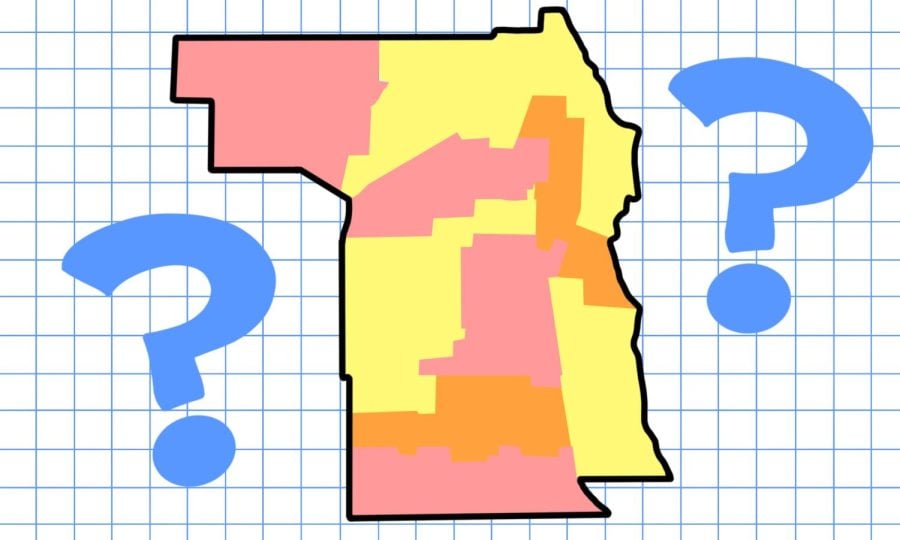Redistricting Committee votes to recommend new ward map to City Council
Daily file illustration by Olivia Abeyta
A map of Evanston’s current wards. The proposed map would impact about 4,000 residents and reduce the difference in ward populations from 20.4% to 2.6%.
May 24, 2023
The Redistricting Committee voted unanimously to recommend a new ward map to City Council on Tuesday night. The proposed map would impact about 4,000 residents’ ward placements and significantly reduce current differences in population between wards.
The council will vote on whether to approve the map June 12. If approved, the changes would be implemented in the 2025 election cycle.
The current map, which was drawn based on the 2000 census, has been in place since 2003. Evanston residents concerned about diluting the voting power of Black voters criticized the last redistricting process. The city decided to forgo redistricting after the 2010 census.
Evanston began the redistricting process in December 2021, aiming to determine a new, more evenly distributed ward map based on the 2020 census. While state law does not require the city to draw new ward lines based on population change, city code calls for wards to be “as nearly equal in population” as possible.
Last year, the committee decided that under the 14th Amendment, the Voting Rights Act of 1965 and federal case law, the 20.4% deviation in population between some wards violates the “one person, one vote” principle. The new map would reduce that number to 2.6%, with the new 9th Ward — planned to be the largest — containing only about 200 people more than the 1st Ward, the smallest.
Ald. Devon Reid (8th) said although population difference between wards would be small, it would still have an effect on the relative representation of residents.
“I would like to note that, for equity sense, the smallest ward means that those voters do get outsize voter influence,” he said.
Early in the redistricting process, the committee established its intent to maintain at least three majority-nonwhite wards, ensure downtown Evanston is represented by multiple wards and pursue an incremental approach to redistricting –– rather than drawing new lines from scratch.
The committee then spent the last year collecting public input on the process, tweaking proposals for new maps to make the wards as even as possible and aiming to minimize the impact on residents.
Ald. Melissa Wynne (3rd) said the city has undergone notable demographic changes in the past two decades that the committee must take into account when redrawing ward lines.
“The two big changes since the last time we redistricted are the outmigration of Black residents and the growing numbers of Hispanic residents,” Wynne said.
During the public comment period of the meeting, some Evanston residents asked how the city would notify people who are moved into new wards.
Ald. Jonathan Nieuwsma (4th) said postcards are usually sent to residents before elections to notify them of their precinct. Information will be included in those cards. The city will also update residents on the process through its newsletter and news releases, he said.
The committee also discussed the equity considerations raised by Evanston residents throughout the redistricting process Tuesday. Nieuwsma said the committee’s incremental approach helps prevent creating new lines that violate the “one person, one vote” principle.
“If we were going to abandon our ‘keep it simple’ philosophy to radically restructure and essentially do a colorblind map … we would impact a whole bunch of people,” Nieuwsma said. “And it’s quite possible we would dilute a nonwhite population so that the argument can legally be made that they would not have adequate representation.”
The proposed map keeps the nonwhite makeup of each ward within two percentage points of the demographics represented under the current map.
Corporation Counsel Nicholas Cummings added that while the city is attempting to maintain the majority nonwhite status of wards 2, 5 and 8, “packing” the city’s minorities into specific wards could run the risk of violating the Fourteenth Amendment.
Nieuwsma said while there have likely been some population changes since the 2020 census, the committee is attempting to “future-proof” the map for the next 10 years.
“One of the reasons we have tried to get as close to zero deviation as possible is to allow population growth in whatever ward,” he said. “And if we get as close to zero as possible, we can accommodate and absorb more growth without perhaps having to redistrict after the 2030 census.”
Email: jacobwendler2025@u.northwestern.edu
Twitter: @jacob_wendler
Related Stories:
— Redistricting Committee implements public feedback



